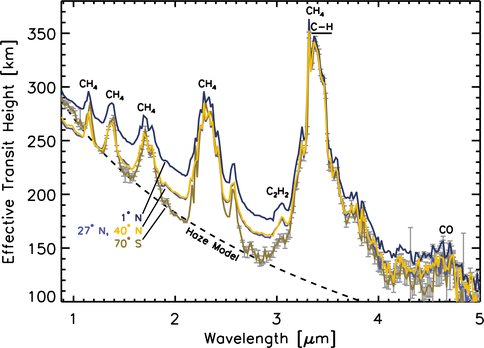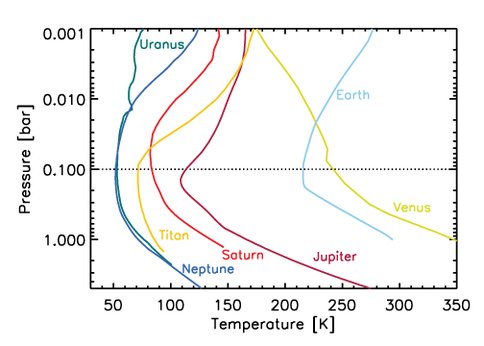2014 Annual Science Report
 VPL at University of Washington
Reporting | SEP 2013 – DEC 2014
VPL at University of Washington
Reporting | SEP 2013 – DEC 2014
Solar System Analogs for Exoplanet Observations
Project Summary
The worlds of our Solar System represent only a fraction of the planetary diversity that likely exists in our Universe. Nevertheless, by studying and characterizing Solar System worlds, we can develop general models that can be applied and tested on exoplanets. Furthermore, by observing planets in the Solar System and studying these data within the context of exoplanet observations, we can provide new context and understanding to exoplanet data. Work in this area this past year includes observations of Titan as seen by Cassini, as an analog for exoplanet observations of hazy worlds; mapping observations of Venus below its cloud deck as an analog for processes and observations of hazy worlds; and the study of multiple atmospheres in the Solar System to understand the basic processes that control their atmospheric temperature structure.
Project Progress
Virtual Planetary Laboratory team members have made many advances in studying Solar System worlds as analogs for exoplanet observations. In Robinson et al. (2014b), Solar occultation data for Titan from the Visual and Infrared Mapping Spectrometer (VIMS) aboard NASA’s Cassini orbiter were used to generate the first-ever transit spectra of a well-studied, haze-rich atmosphere (Figure 1). These observations shed new light on how atmospheric hazes can limit our ability to characterize super-Earths.
Continuing on the theme of studying hazy Solar System worlds, Arney, Meadows and Crisp published an extensive analysis of ground-based observations of Venus. Venus may represent the end-state of terrestrial planet evolution, and Venus-like analogs may be common in the exoplanet population. To better understand the Venus lower atmosphere, we observed the Venus near-infrared nightside spectral windows from the ground to produce the first simultaneous maps of lower atmosphere cloud opacity, droplet sulfuric acid percentage, and trace gases (H2O, SO2, HCl, OCS, and CO). These maps reveal interrelationships of multiple chemical species: OCS and CO show a strong anti-correlation indicating chemical conversion between these species, and water vapor displays a surprising banding pattern on some nights that may be associated with rainout.
Virtual Planetary Laboratory team members have also participated in projects related to comparative planetology of planetary atmospheres and orbital dynamics. In Robinson and Catling (2014), VPL scientists used simple models to explain why Earth, Titan, Jupiter, Saturn, Uranus, and Neptune all have a local minimum in their atmospheric temperatures near 0.1 bar (Figure 2). By understanding the generalities of this phenomenon, Robinson and Catling were able to conclude that many exoplanets will also have 0.1 bar temperature minima, which could be used to help deduce the surface temperature or pressure of a potentially Earth-like planet, thereby constraining its habitability. And, finally, in Kane et al. (2013), VPL team member Sean Raymond collaborated on an interpretation of compact Kepler multi-planet systems based on our understanding of moon systems in the Solar System.
Publications
-
Arney, G., Meadows, V., Crisp, D., Schmidt, S. J., Bailey, J., & Robinson, T. (2014). Spatially resolved measurements of H2O, HCl, CO, OCS, SO2, cloud opacity, and acid concentration in the Venus near-infrared spectral windows. Journal of Geophysical Research: Planets, 119(8), 1860–1891. doi:10.1002/2014je004662
-
Kane, S. R., Hinkel, N. R., & Raymond, S. N. (2013). SOLAR SYSTEM MOONS AS ANALOGS FOR COMPACT EXOPLANETARY SYSTEMS. The Astronomical Journal, 146(5), 122. doi:10.1088/0004-6256/146/5/122
-
Robinson, T. D., & Catling, D. C. (2013). Common 0.1 bar tropopause in thick atmospheres set by pressure-dependent infrared transparency. Nature Geosci, 7(1), 12–15. doi:10.1038/ngeo2020
-
Robinson, T. D., Maltagliati, L., Marley, M. S., & Fortney, J. J. (2014). Titan solar occultation observations reveal transit spectra of a hazy world. Proceedings of the National Academy of Sciences, 111(25), 9042–9047. doi:10.1073/pnas.1403473111
-
PROJECT INVESTIGATORS:
-
PROJECT MEMBERS:
Giada Arney
Project Investigator
David Catling
Co-Investigator
David Crisp
Co-Investigator
Jeremy Bailey
Collaborator
-
RELATED OBJECTIVES:
Objective 1.2
Indirect and direct astronomical observations of extrasolar habitable planets.
Objective 7.2
Biosignatures to be sought in nearby planetary systems



